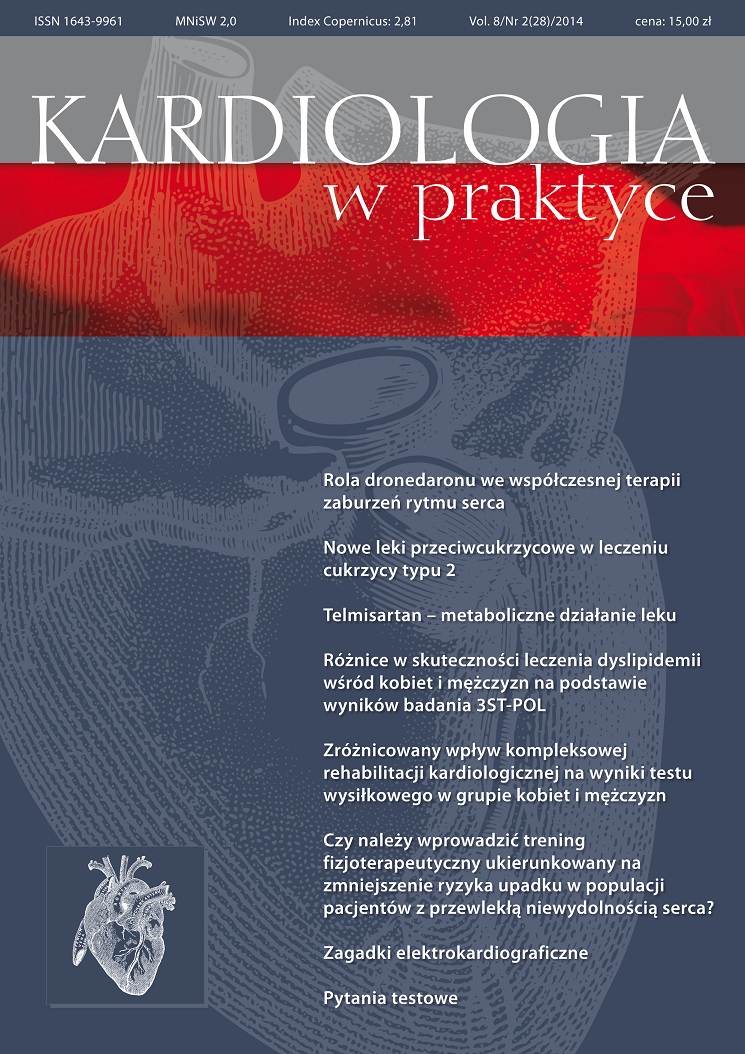Czy należy wprowadzić trening fizjoterapeutyczny ukierunkowany na zmniejszenie ryzyka upadku w populacji pacjentów z przewlekłą niewydolnością serca? Artykuł przeglądowy
##plugins.themes.bootstrap3.article.main##
Abstrakt
Upadek u osób starszych może wywołać bardzo poważne konsekwencje, takie jak złamania czy urazy czaszkowo-mózgowe. Wzrost długości życia w ciągu ostatnich kilku dziesięcioleci niesie za sobą konieczność zwiększenia starań o redukcję ryzyka upadku i jego następstw. Nie jest to już bowiem problem marginalnej części społeczeństwa. Ponadto pacjenci z przewlekłą niewydolnością serca stanowili dotychczas jedynie część populacji badanej pod kątem zmniejszenia ryzyka upadku. Warto jednak stworzyć program ćwiczeń dla tej konkretnej grupy według najnowszych metod terapii i diagnostyki w celu poprawy jakości jej życia.
Pobrania
##plugins.themes.bootstrap3.article.details##

Utwór dostępny jest na licencji Creative Commons Uznanie autorstwa – Użycie niekomercyjne – Bez utworów zależnych 4.0 Międzynarodowe.
Copyright: © Medical Education sp. z o.o. This is an Open Access article distributed under the terms of the Attribution-NonCommercial 4.0 International (CC BY-NC 4.0). License (https://creativecommons.org/licenses/by-nc/4.0/), allowing third parties to copy and redistribute the material in any medium or format and to remix, transform, and build upon the material, provided the original work is properly cited and states its license.
Address reprint requests to: Medical Education, Marcin Kuźma (marcin.kuzma@mededu.pl)
Bibliografia
2. Żak M.: Rehabilitacja w procesie leczenia osób starszych. Geront. Pol. 2008; (I): 12-18.
3. Błaszczyk J.W., Czerwosz L.: Stabilność posturalna w procesie starzenia. Geront. Pol. 2005; 13(1): 25-36.
4. Gillespie L.D., Robertson M.C. et al.: Interventions for preventing falls in older people living in the community 2009. Cochrane Database Systematic Reviews 2 (CD007146).
5. Sethi D., Racioppi F., Baumgarten I., Vida P.: Injuries and violence in Europe. Why they matter and what can be done. WHO Regional Office for Europe. Copenhagen 2006.
6. Online: http://www.euro.who.int/__data/assets/pdf_file/0005/98762/E88037.pdf.
7. Gorzkowska A., Opala G.: Rehabilitacja w wieku podeszłym. Post. N. Med. 2010; 6: 492.
8. Podsiadlo D., Richardson S.: The Timed “Up & Go”: A test of basic functional mobility for frail elderly persons. J. Am. Geriatr. Soc. 1991; 39: 142-148.
9. Tinetti M.E., Williams T.E., Mayewski R.: Fall risk index for elderly patients based on number of chronic disabilities. Am. J. Med. 1986; 80(3): 429-434.
10. Duncan P.W., Weiner D.K., Chandler J., Studensky J.: Functional reach: a new clinical measure of balance. J. Geront. 1990; 45(6): 192-197.
11. Mackenzie L., Clemson L.: Can chronic disease management plans including occupational therapy and physiotherapy services contribute to reducing falls risk in older people? Australian family physician 2014; 43(4): 211.
12. Campbell A.J., Robertson M.C., Gardner M.M. et al.: Falls prevention over 2 years: a randomized controlled trial in women 80 years and older. Age and ageing 1999; 28(6): 513-518.
13. Nitz J.C., Low Choy N.: The efficacy of a specific balance-strategy training program for preventing falls among older people: a pilot randomized controlled trial. Age and Ageing 2004; 33: 52-58.
14. Wong K.A.M., Lin Y.C., Chou S.W.: Coordination exercise and postural stability in elderly people: effect of Tai Chi Chuan. Archives of physicalmedicine and rehabilitation 2001; 82(5): 608-612.
15. Twardowska-Rajewska J.: Krótki program usprawniania seniorów w celu minimalizowania zaburzeń równowagi. Geront. Pol. 2006; 14(1): 41-45.
16. Szpringer M., Wybraniec-Lewicka B., Czerwiak G. et al.: Upadki i urazy wieku geriatrycznego. Stud. Med. 2008; 9: 77-81.
17. Hauer K., Rost B., Rutschle K. et al.: Exercise training for rehabilitation and secondary prevention of falls in geriatric patients with a history of injurious falls. J. Am. Geriatr. Soc. 2001; 49(1): 10-20.
